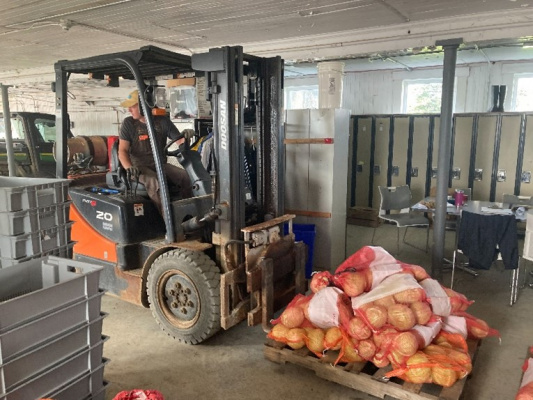
Scientists and technicians harvest crops by hand in a field.
Food for thought: it’s estimated that over half of Canada’s food supply is lost or wasted throughout our food systems, equalling roughly $50 billion worth of food, while food prices increase. This is during a time when almost 1 in every 6 Canadians report not having enough money to buy food. Even our environment is affected; food waste makes up almost a quarter of our landfill waste and releases methane. Globally, it is estimated that food loss and waste accounts for 8% of greenhouse gas emissions.
Food waste is a big issue that Agriculture and Agri-Food Canada (AAFC) is working to address through initiatives like the Food Waste Reduction Challenge that was launched as part of the Food Policy for Canada. Though, an issue this large requires as much inventiveness as possible.
AAFC Research and Development Centres (RDC) across Canada produce tonnes of crops each year, all for the sake of ensuring the continued sustainability of Canada’s agriculture industry. Some of these surplus crops go into the compost, eventually turning into fertilizer for the next season’s crop, while others are used as animal feed. Even after this, in some regions, there may still be unused crops that end up in landfills.

A forklift moving a pallet of crops from storage.
Enter Leanne Wilson, Associate Director at the AAFC St. John’s RDC, who saw the potential for research centres to reduce food waste by donating surplus crops to local food banks. Not wanting anything to go to waste, Leanne recently worked with GCSurplus, Food Banks Canada and Second Harvest to help surplus crops get into food insecure households across Canada. This project is now going strong across several AAFC RDCs in Newfoundland and Labrador, Nova Scotia, Prince Edward Island, New Brunswick, Quebec, and British Columbia.
“It’s important for us to show that we are trying, in our own way, to reduce food waste. Any manner that we can do this, as well as help provide support to local food banks across Canada, is a win for everyone,” says Leanne.
So far, in the project’s second year, tens of thousands of pounds of AAFC crops have been donated to food banks across Canada:
- More than 8,200 pounds of carrots, potatoes, lettuce, rutabaga, cabbage, broccoli and cranberries made their way from the St. John’s RDC farm fields to The Community Food Sharing Association across Newfoundland and Labrador.
- The first crop of hydroponic lettuce (50 heads) was donated from the Kentville RDC to the Community Food Resource Network in Caledonia, Nova Scotia, at the end of March, with much more to come.
- The Charlottetown RDC donated more than 10,000 pounds of potatoes to the Upper Room Hospitality Ministry to be distributed throughout Prince Edward Island.
- The Food Depot Alimentaire in Moncton, New Brunswick, received more than 15,000 pounds of potatoes from the Fredericton RDC.
- In Quebec, the St-Jean-sur-Richelieu RDC sent 15,000 pounds of onions, 8,000 pounds of potatoes, and 220 pounds of cabbage to Second Harvest. The Sherbrooke RDC took part in the milk donation program coordinated by Les Producteurs de lait du Québec. In 2023, they will donate 250 litres of milk per month to the Quebec Association of Food Banks and Second Harvest for an annual total of 3,000 litres.
- At the Summerland RDC in British Columbia, more than 1,200 pounds of apples and 2,500 pounds of pears went to the Central Okanagan Food Bank in Kelowna. The Agassiz RDC donated more than 1,000 pounds of blueberries to the Chilliwack & District Seniors Resources Society and another 500 pounds of blueberries to Chilliwack Community Services.
As the need for fresh and healthy foods remains, the AAFC research and development centres plan to continue donations in the coming seasons and hope that their efforts will support local food banks, and Canadian families for years to come.
Learn more about Leanne Wilson and how this crop donation project came to fruition.
Related information:
- St. John’s Research and Development Centre
- Kentville Research and Development Centre
- Charlottetown Research and Development Centre
- Fredericton Research and Development Centre
- St-Jean-sur-Richelieu Research and Development Centre
- Sherbrooke Research and Development Centre
- Agassiz Research and Development Centre
- Summerland Research and Development Centre
Get more Agri-info
- Want more stories like this? Explore what else Agri-info has to offer.
- Interested in reporting on this story? Contact AAFC Media Relations at aafc.mediarelations-relationsmedias.aac@agr.gc.ca to arrange an interview with one of our experts.